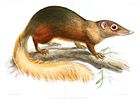
Carnivora is a monophyletic order of placental mammals consisting of the most recent common ancestor of all cat-like and dog-like animals, and all descendants of that ancestor. Members of this group are formally referred to as carnivorans, and have evolved to specialize in eating flesh. The order is the fifth largest order of mammals, comprising at least 279 species.

Felidae is a family of mammals in the order Carnivora, colloquially referred to as cats, and constitutes a clade. A member of this family is also called a felid. The term "cat" refers both to felids in general and specifically to the domestic cat.
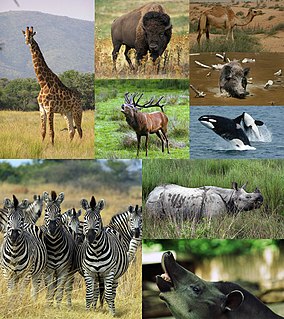
Ungulates are members of the diverse clade Ungulata which primarily consists of large mammals with hooves. These include odd-toed ungulates such as horses, rhinoceroses, and tapirs; and even-toed ungulates such as cattle, pigs, giraffes, camels, sheep, deer, and hippopotamuses. Cetaceans such as whales, dolphins, and porpoises are also classified as even-toed ungulates, although they do not have hooves. Most terrestrial ungulates use the hoofed tips of their toes to support their body weight while standing or moving.

Xenarthra is a major clade of placental mammals native to the Americas. There are 31 living species: the anteaters, tree sloths, and armadillos. Extinct xenarthrans include the glyptodonts, pampatheres and ground sloths. Xenarthrans originated in South America during the late Paleocene about 60 million years ago. They evolved and diversified extensively in South America during the continent's long period of isolation in the early to mid Cenozoic Era. They spread to the Antilles by the early Miocene and, starting about 3 Mya, spread to Central and North America as part of the Great American Interchange. Nearly all of the formerly abundant megafaunal xenarthrans became extinct at the end of the Pleistocene.

Metatheria is a mammalian clade that includes all mammals more closely related to marsupials than to placentals. First proposed by Thomas Henry Huxley in 1880, it is a more inclusive group than the marsupials; it contains all marsupials as well as many extinct non-marsupial relatives.

Tylopoda is a suborder of terrestrial herbivorous even-toed ungulates belonging to the order Artiodactyla. They are found in the wild in their native ranges of South America and Asia, while Australian feral camels are introduced. The group has a long fossil history in North America and Eurasia. Tylopoda appeared during the Eocene around 50 million years ago.

Euarchontoglires is a clade and a superorder of mammals, the living members of which belong to one of the five following groups: rodents, lagomorphs, treeshrews, colugos, and primates.
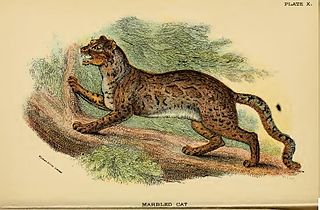
Pardofelis is a genus of the cat family Felidae. This genus is defined as including one species native to Southeast Asia: the marbled cat. Two other species, formerly classified to this genus, now belong to the genus Catopuma.
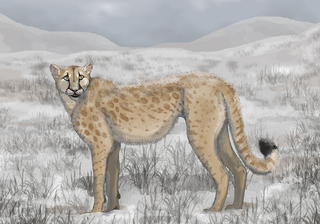
The American cheetah is either of two feline species of the extinct genus Miracinonyx, endemic to North America during the Pleistocene epoch and morphologically similar to the modern cheetah. These cats were originally known from fragments of skeletons, but nearly complete skeletons have been recovered from Natural Trap Cave in northern Wyoming.

The Great American Biotic Interchange, also known as the Great American Interchange and the Great American Faunal Interchange, was an important late Cenozoic paleozoogeographic biotic interchange event in which land and freshwater fauna migrated from North America via Central America to South America and vice versa, as the volcanic Isthmus of Panama rose up from the sea floor and bridged the formerly separated continents. Although earlier dispersals had occurred, probably over water, the migration accelerated dramatically about 2.7 million years (Ma) ago during the Piacenzian age. It resulted in the joining of the Neotropic and Nearctic biogeographic realms definitively to form the Americas. The interchange is visible from observation of both biostratigraphy and nature (neontology). Its most dramatic effect is on the zoogeography of mammals, but it also gave an opportunity for reptiles, amphibians, arthropods, weak-flying or flightless birds, and even freshwater fish to migrate. Coastal and marine biota, however, was affected in the opposite manner; the formation of the Central American Isthmus caused what has been termed the Great American Schism, with significant diversification and extinction occurring as a result of the isolation of the Caribbean from the Pacific.

Mesonychia is an extinct taxon of small- to large-sized carnivorous ungulates related to artiodactyls. Mesonychids first appeared in the early Paleocene, went into a sharp decline at the end of the Eocene, and died out entirely when the last genus, Mongolestes, became extinct in the early Oligocene. In Asia, the record of their history suggests they grew gradually larger and more predatory over time, then shifted to scavenging and bone-crushing lifestyles before the group became extinct.
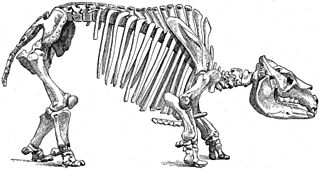
Notoungulata is an extinct order of mammalian ungulates that inhabited South America from the early Paleocene to the Holocene, living from approximately 61 million to 11,000 years ago. Notoungulates were morphologically diverse, with forms resembling animals as disparate as rabbits and rhinoceroses. Notoungulata are the largest group of South American native ungulates, with over 150 genera in 14 families having been described, divided into two major subgroupings, Typotheria and Toxodontia. Notoungulates first diversified during the Eocene. Their diversity declined during the Late Neogene, with only the large toxodontids persisting until the end of the Pleistocene. Collagen analysis suggests that notoungulates are closely related to litopterns, another group of South American ungulates, and their closest living relatives being perissodactyls, including rhinoceroses, tapirs and equines. but their relationships to other South American ungulates are uncertain. Several groups of notoungulates separately evolved ever growing teeth like rodents and lagomorphs, a distinction among ungulates only shared with Elasmotherium.

South American native ungulates, commonly abbreviated as SANUs, are extinct ungulate-like mammals of controversial affinities that were indigenous to South America prior to the Great American Biotic Interchange. They comprise five major groups conventionally ranked as orders—Astrapotheria, Litopterna, Notoungulata, Pyrotheria, and Xenungulata—as well as some other taxa, such as Didolodontidae and Kollpaniidae. It has been proposed that some or all of the members of this group form a clade, named Meridiungulata, though the relationships of South American ungulates remain largely unresolved. The two largest groups of South American ungulates, the notoungulates and the litopterns, were the only groups to persist beyond the mid Miocene. Only a few of the largest species of notoungulates and litopterns survived until the end-Pleistocene extinctions.

Miacis is a genus of extinct carnivorous mammals that appeared in the late Paleocene and continued through the Eocene. The genus Miacis is not monophyletic but a diverse collection of species that belong to the stemgroup within the Carnivoramorpha. As such, most Miacis species belong to the group of early carnivores that represent the ancestors of the modern order, the crown-group Carnivora. However, the species Miacis cognitus is placed not in the stem-group but among the Caniformia, one of the two suborders of the crown-group Carnivora.

Xenungulata is an order of extinct and primitive South American hoofed mammals that lived from the Late Paleocene to Early Eocene. Fossils of the order are known from deposits in Brazil, Argentina, Peru, and Colombia. The best known member of this enigmatic order is the genus Carodnia, a tapir-like and -sized animal with a gait similar to living African elephants.

Megalonychidae is an extinct family of sloths including the extinct Megalonyx. Megalonychids first appeared in the early Oligocene, about 35 million years (Ma) ago, in southern Argentina (Patagonia). There is actually one possible find dating to the Eocene, about 40 Ma ago, on Seymour Island in Antarctica. They first reached North America by island-hopping across the Central American Seaway, about 9 million years ago, prior to formation of the Isthmus of Panama about 2.7 million years ago. Some megalonychid lineages increased in size as time passed. The first species of these were small and may have been partly tree-dwelling, whereas the Pliocene species were already approximately half the size of the huge Late Pleistocene Megalonyx jeffersonii from the last ice age.
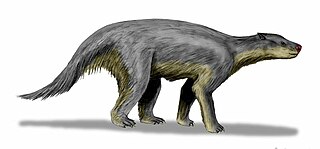
Pantodonta is an extinct suborder of eutherian mammals. These herbivorous mammals were one of the first groups of large mammals to evolve after the end of the Cretaceous. The last pantodonts died out at the end of the Eocene.

Carnivoramorpha is a clade of placental mammals that includes the modern order Carnivora and its extinct stem-relatives.

Nyctitheriidae is a family of extinct eulipotyphlan insectivores known from the Paleocene and Eocene epochs of North America and Asia and persisting into the Oligocene of Europe. Several genera, including Nyctitherium, Paradoxonycteris, and Wyonycteris, have initially been described as bats, although the family is more frequently placed in the order Eulipotyphla.

Pholidotamorpha ("pangolin-shaped") is a clade of mammals that includes the orders Palaeanodonta and Pholidota.





















